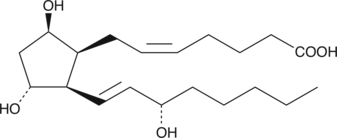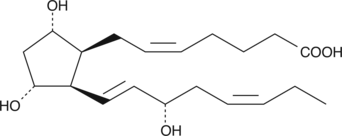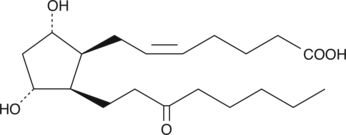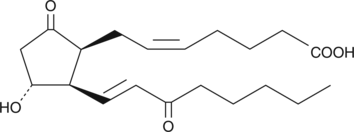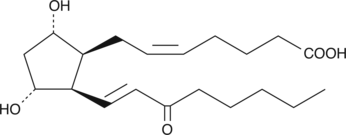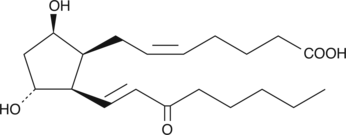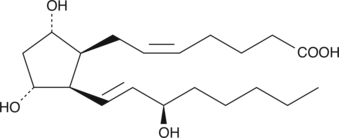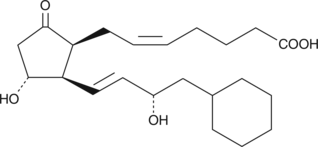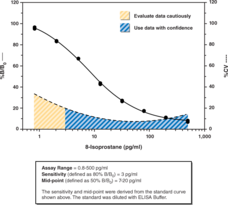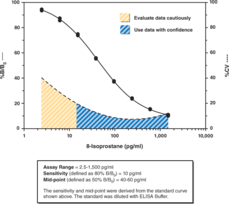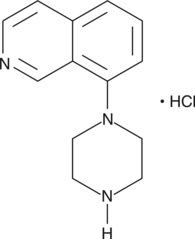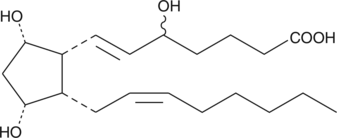Cayman
Showing 7501–7650 of 45550 results
-
8-iso PGF2α-d4 contains four deuterium atoms at the 3, 3′, 4, and 4′ positions. It is intended for use as an internal standard for the quantification of 8-iso PGF2α by GC- or LC-mass spectrometry. 8-iso Prostaglandin F2α (8-iso PGF2α) is an isoprostane produced by the non-enzymatic peroxidation of arachidonic acid in membrane phospholipids.{320,371,855} It circulates in human plasma in two distinct forms – esterified in LDL phospholipids and as the free acid. The ratio of these two forms is approximately 2:1, with a total plasma 8-iso PGF2α level of about 150 pg/ml in normal volunteers. In normal human urine, 8-iso PGF2α levels are about 180-200 pg/mg of creatinine.{320,371} 8-iso PGF2α is a weak TP receptor agonist in vascular smooth muscle.{6640} Conversely, 8-iso PGF2α inhibits platelet aggregation induced by U-46619 (10−6 M) and I-BOP (3 x 10−7 M) with IC50 values of 1.6 x 10−6 M and 1.8 x 10−6 M, respectively.{855}
Brand:CaymanSKU:316350 - 500 µgAvailable on backorder
8-iso Prostaglandin F2β (8-iso PGF2β) is an isomer of PGF2α with a non-enzymatic, non-cyclooxygenase origin. It is one of 64 possible isomers of PGF2α which can be produced by free radical peroxidation of arachidonic acid. 8-iso PGF2β exhibits very weak contraction of human umbilical vein artery{11143} and does not promote aggregation of human whole blood.{11143,11145} However, 8-iso PGF2β moderately contracts both the canine and porcine pulmonary vein, although the effect is much weaker than that exhibited by other isoprostanes such as 8-iso PGE1, 8-iso PGE2, or 8-iso PGF2α{11144,11146}
Brand:CaymanSKU:-Out of stock
8-iso Prostaglandin F2β (8-iso PGF2β) is an isomer of PGF2α with a non-enzymatic, non-cyclooxygenase origin. It is one of 64 possible isomers of PGF2α which can be produced by free radical peroxidation of arachidonic acid. 8-iso PGF2β exhibits very weak contraction of human umbilical vein artery{11143} and does not promote aggregation of human whole blood.{11143,11145} However, 8-iso PGF2β moderately contracts both the canine and porcine pulmonary vein, although the effect is much weaker than that exhibited by other isoprostanes such as 8-iso PGE1, 8-iso PGE2, or 8-iso PGF2α{11144,11146}
Brand:CaymanSKU:-Out of stock
8-iso Prostaglandin F2β (8-iso PGF2β) is an isomer of PGF2α with a non-enzymatic, non-cyclooxygenase origin. It is one of 64 possible isomers of PGF2α which can be produced by free radical peroxidation of arachidonic acid. 8-iso PGF2β exhibits very weak contraction of human umbilical vein artery{11143} and does not promote aggregation of human whole blood.{11143,11145} However, 8-iso PGF2β moderately contracts both the canine and porcine pulmonary vein, although the effect is much weaker than that exhibited by other isoprostanes such as 8-iso PGE1, 8-iso PGE2, or 8-iso PGF2α{11144,11146}
Brand:CaymanSKU:-Out of stock
8-iso PGF3α is an isoprostane produced from the free-radical peroxidation of EPA. Little is known about the biological activity of 8-iso PGF3α. There is one report that it is inactive in a TP receptor mediated assay of human platelet shape change, where 8-iso PGF2α has an ED50 value of 1 µM.{2772}
Brand:CaymanSKU:-Out of stock
8-iso PGF3α is an isoprostane produced from the free-radical peroxidation of EPA. Little is known about the biological activity of 8-iso PGF3α. There is one report that it is inactive in a TP receptor mediated assay of human platelet shape change, where 8-iso PGF2α has an ED50 value of 1 µM.{2772}
Brand:CaymanSKU:-Out of stock
8-iso PGF3α is an isoprostane produced from the free-radical peroxidation of EPA. Little is known about the biological activity of 8-iso PGF3α. There is one report that it is inactive in a TP receptor mediated assay of human platelet shape change, where 8-iso PGF2α has an ED50 value of 1 µM.{2772}
Brand:CaymanSKU:-Out of stock
8-iso-13,14-dihydro-15-keto Prostaglandin F2α (8-iso-13,14-dihydro-15-keto PGF2α) is a metabolite of the isoprostane, 8-isoprostane (8-iso PGF2α), in rabbits, monkeys and humans.{6907} 8-iso PGF2α is a PG-like product of non-specific lipid peroxidation.{320} In both humans and monkeys, exogenously infused 8-isoprostane is converted primarily to metabolites having 2 or 4 carbon atoms removed from the top side chain by β-oxidation.{6907} A similar pattern is observed when tritiated 8-isoprostane is infused into rabbits.{11209} Early in the infusion (within 10 minutes) 8-iso-13,14-dihydro-15-keto PGF2α was a significant component of the metabolite profile, which was comprised mostly of dinor 8-isoprostane metabolites. 8-iso-13,14-dihydro-15-keto PGF2α weakly inhibits the U-46619 or collagen-induced aggregation of human platelets, although a number of the E-series isoprostanes are much more potent in this assay.{11145}
Brand:CaymanSKU:-Out of stock
8-iso-13,14-dihydro-15-keto Prostaglandin F2α (8-iso-13,14-dihydro-15-keto PGF2α) is a metabolite of the isoprostane, 8-isoprostane (8-iso PGF2α), in rabbits, monkeys and humans.{6907} 8-iso PGF2α is a PG-like product of non-specific lipid peroxidation.{320} In both humans and monkeys, exogenously infused 8-isoprostane is converted primarily to metabolites having 2 or 4 carbon atoms removed from the top side chain by β-oxidation.{6907} A similar pattern is observed when tritiated 8-isoprostane is infused into rabbits.{11209} Early in the infusion (within 10 minutes) 8-iso-13,14-dihydro-15-keto PGF2α was a significant component of the metabolite profile, which was comprised mostly of dinor 8-isoprostane metabolites. 8-iso-13,14-dihydro-15-keto PGF2α weakly inhibits the U-46619 or collagen-induced aggregation of human platelets, although a number of the E-series isoprostanes are much more potent in this assay.{11145}
Brand:CaymanSKU:-Out of stock
8-iso-13,14-dihydro-15-keto Prostaglandin F2α (8-iso-13,14-dihydro-15-keto PGF2α) is a metabolite of the isoprostane, 8-isoprostane (8-iso PGF2α), in rabbits, monkeys and humans.{6907} 8-iso PGF2α is a PG-like product of non-specific lipid peroxidation.{320} In both humans and monkeys, exogenously infused 8-isoprostane is converted primarily to metabolites having 2 or 4 carbon atoms removed from the top side chain by β-oxidation.{6907} A similar pattern is observed when tritiated 8-isoprostane is infused into rabbits.{11209} Early in the infusion (within 10 minutes) 8-iso-13,14-dihydro-15-keto PGF2α was a significant component of the metabolite profile, which was comprised mostly of dinor 8-isoprostane metabolites. 8-iso-13,14-dihydro-15-keto PGF2α weakly inhibits the U-46619 or collagen-induced aggregation of human platelets, although a number of the E-series isoprostanes are much more potent in this assay.{11145}
Brand:CaymanSKU:-Out of stock
8-iso-13,14-dihydro-15-keto Prostaglandin F2α (8-iso-13,14-dihydro-15-keto PGF2α) is a metabolite of the isoprostane, 8-isoprostane (8-iso PGF2α), in rabbits, monkeys and humans.{6907} 8-iso PGF2α is a PG-like product of non-specific lipid peroxidation.{320} In both humans and monkeys, exogenously infused 8-isoprostane is converted primarily to metabolites having 2 or 4 carbon atoms removed from the top side chain by β-oxidation.{6907} A similar pattern is observed when tritiated 8-isoprostane is infused into rabbits.{11209} Early in the infusion (within 10 minutes) 8-iso-13,14-dihydro-15-keto PGF2α was a significant component of the metabolite profile, which was comprised mostly of dinor 8-isoprostane metabolites. 8-iso-13,14-dihydro-15-keto PGF2α weakly inhibits the U-46619 or collagen-induced aggregation of human platelets, although a number of the E-series isoprostanes are much more potent in this assay.{11145}
Brand:CaymanSKU:-Out of stock
8-iso-15-keto Prostaglandin E2 (8-iso-15-keto PGE2) is an isoprostane, one member of a large family of biomarkers produced by the free radical peroxidative degradation of membrane lipids.{320} 8-iso-15-keto PGE2 is the theoretical first metabolite of 8-iso PGE2 via the 15-hydroxy PGDH pathway. While a number of potent biological activities have been attributed to 8-iso PGE2,{1258} there are no published reports at this time regarding its metabolism.
Brand:CaymanSKU:-8-iso-15-keto Prostaglandin E2 (8-iso-15-keto PGE2) is an isoprostane, one member of a large family of biomarkers produced by the free radical peroxidative degradation of membrane lipids.{320} 8-iso-15-keto PGE2 is the theoretical first metabolite of 8-iso PGE2 via the 15-hydroxy PGDH pathway. While a number of potent biological activities have been attributed to 8-iso PGE2,{1258} there are no published reports at this time regarding its metabolism.
Brand:CaymanSKU:-8-iso-15-keto Prostaglandin E2 (8-iso-15-keto PGE2) is an isoprostane, one member of a large family of biomarkers produced by the free radical peroxidative degradation of membrane lipids.{320} 8-iso-15-keto PGE2 is the theoretical first metabolite of 8-iso PGE2 via the 15-hydroxy PGDH pathway. While a number of potent biological activities have been attributed to 8-iso PGE2,{1258} there are no published reports at this time regarding its metabolism.
Brand:CaymanSKU:-8-iso-15-keto Prostaglandin E2 (8-iso-15-keto PGE2) is an isoprostane, one member of a large family of biomarkers produced by the free radical peroxidative degradation of membrane lipids.{320} 8-iso-15-keto PGE2 is the theoretical first metabolite of 8-iso PGE2 via the 15-hydroxy PGDH pathway. While a number of potent biological activities have been attributed to 8-iso PGE2,{1258} there are no published reports at this time regarding its metabolism.
Brand:CaymanSKU:-8-iso-15-keto Prostaglandin F2α (8-iso-15-keto PGF2α) is a metabolite of the isoprostane 8-iso PGF2α in rabbits, monkeys, and humans. 8-isoprostane (8-iso PGF2α) is a prostaglandin-like product of non-specific lipid peroxidation.{320} In both humans and monkeys, exogenously infused 8-iso PGF2α is converted primarily to metabolites having 2 or 4 carbon atoms removed from the top side chain by β-oxidation.{6907} A similar pattern is observed when tritiated 8-iso PGF2α is infused into rabbits.{11209} Early in the infusion (within 1-2 minutes) 8-iso -15-keto PGF2α was a major component of the metabolite profile, which was comprised mostly of unmetabolized 8-iso PGF2α. 8-iso -15-keto PGF2α is a vasoconstrictor when tested on the rat isolated thoracic aorta, acting via the TP (thromboxane) receptor.{11221}
Brand:CaymanSKU:-Out of stock
8-iso-15-keto Prostaglandin F2α (8-iso-15-keto PGF2α) is a metabolite of the isoprostane 8-iso PGF2α in rabbits, monkeys, and humans. 8-isoprostane (8-iso PGF2α) is a prostaglandin-like product of non-specific lipid peroxidation.{320} In both humans and monkeys, exogenously infused 8-iso PGF2α is converted primarily to metabolites having 2 or 4 carbon atoms removed from the top side chain by β-oxidation.{6907} A similar pattern is observed when tritiated 8-iso PGF2α is infused into rabbits.{11209} Early in the infusion (within 1-2 minutes) 8-iso -15-keto PGF2α was a major component of the metabolite profile, which was comprised mostly of unmetabolized 8-iso PGF2α. 8-iso -15-keto PGF2α is a vasoconstrictor when tested on the rat isolated thoracic aorta, acting via the TP (thromboxane) receptor.{11221}
Brand:CaymanSKU:-Out of stock
8-iso-15-keto Prostaglandin F2α (8-iso-15-keto PGF2α) is a metabolite of the isoprostane 8-iso PGF2α in rabbits, monkeys, and humans. 8-isoprostane (8-iso PGF2α) is a prostaglandin-like product of non-specific lipid peroxidation.{320} In both humans and monkeys, exogenously infused 8-iso PGF2α is converted primarily to metabolites having 2 or 4 carbon atoms removed from the top side chain by β-oxidation.{6907} A similar pattern is observed when tritiated 8-iso PGF2α is infused into rabbits.{11209} Early in the infusion (within 1-2 minutes) 8-iso -15-keto PGF2α was a major component of the metabolite profile, which was comprised mostly of unmetabolized 8-iso PGF2α. 8-iso -15-keto PGF2α is a vasoconstrictor when tested on the rat isolated thoracic aorta, acting via the TP (thromboxane) receptor.{11221}
Brand:CaymanSKU:-Out of stock
8-iso Prostaglandin F2β (8-iso PGF2β) is an isomer of PGF2α of non-enzymatic origin. It is one of 64 possible isomers of PGF2α which can be produced by free radical peroxidation of arachidonic acid. 8-iso PGF2β exhibits very weak contraction of human umbilical vein artery and does not promote aggregation of human whole blood.{11143,11145} However, 8-iso PGF2β moderately contracts both the canine and porcine pulmonary vein, although the effect is much weaker than that exhibited by other isoprostanes such as 8-iso PGE1, 8-iso PGE2, or 8-iso PGF2α.{11144,11146} 8-iso-15-keto PGF2β is a potential metabolite of 8-iso PGF2β via the 15-hydroxy PG dehydrogenase pathway. There are no published reports on the formation or biological activity of 8-iso-15-keto PGF2β.
Brand:CaymanSKU:10008539 - 1 mgAvailable on backorder
8-iso Prostaglandin F2β (8-iso PGF2β) is an isomer of PGF2α of non-enzymatic origin. It is one of 64 possible isomers of PGF2α which can be produced by free radical peroxidation of arachidonic acid. 8-iso PGF2β exhibits very weak contraction of human umbilical vein artery and does not promote aggregation of human whole blood.{11143,11145} However, 8-iso PGF2β moderately contracts both the canine and porcine pulmonary vein, although the effect is much weaker than that exhibited by other isoprostanes such as 8-iso PGE1, 8-iso PGE2, or 8-iso PGF2α.{11144,11146} 8-iso-15-keto PGF2β is a potential metabolite of 8-iso PGF2β via the 15-hydroxy PG dehydrogenase pathway. There are no published reports on the formation or biological activity of 8-iso-15-keto PGF2β.
Brand:CaymanSKU:10008539 - 100 µgAvailable on backorder
8-iso Prostaglandin F2β (8-iso PGF2β) is an isomer of PGF2α of non-enzymatic origin. It is one of 64 possible isomers of PGF2α which can be produced by free radical peroxidation of arachidonic acid. 8-iso PGF2β exhibits very weak contraction of human umbilical vein artery and does not promote aggregation of human whole blood.{11143,11145} However, 8-iso PGF2β moderately contracts both the canine and porcine pulmonary vein, although the effect is much weaker than that exhibited by other isoprostanes such as 8-iso PGE1, 8-iso PGE2, or 8-iso PGF2α.{11144,11146} 8-iso-15-keto PGF2β is a potential metabolite of 8-iso PGF2β via the 15-hydroxy PG dehydrogenase pathway. There are no published reports on the formation or biological activity of 8-iso-15-keto PGF2β.
Brand:CaymanSKU:10008539 - 500 µgAvailable on backorder
8-iso-15(R) PGF2α is one member of a large family of prostaglandin-like eicosanoids formed by the free radical peroxidation of arachidonic acid in membrane phospholipids.{371} It is the C-15 epimer of 8-iso PGF2α, the only isoprostane isomer which has been studied in depth in a variety of biological systems.{855}
Brand:CaymanSKU:-Out of stock
8-iso-15(R) PGF2α is one member of a large family of prostaglandin-like eicosanoids formed by the free radical peroxidation of arachidonic acid in membrane phospholipids.{371} It is the C-15 epimer of 8-iso PGF2α, the only isoprostane isomer which has been studied in depth in a variety of biological systems.{855}
Brand:CaymanSKU:-Out of stock
8-iso-15(R) PGF2α is one member of a large family of prostaglandin-like eicosanoids formed by the free radical peroxidation of arachidonic acid in membrane phospholipids.{371} It is the C-15 epimer of 8-iso PGF2α, the only isoprostane isomer which has been studied in depth in a variety of biological systems.{855}
Brand:CaymanSKU:-Out of stock
8-iso-15(R) PGF2α is one member of a large family of prostaglandin-like eicosanoids formed by the free radical peroxidation of arachidonic acid in membrane phospholipids.{371} It is the C-15 epimer of 8-iso PGF2α, the only isoprostane isomer which has been studied in depth in a variety of biological systems.{855}
Brand:CaymanSKU:-Out of stock
8-iso Prostaglandin E2 (8-iso PGE2) is one of several isoprostanes produced from polyunsaturated fatty acids during lipid peroxidation.{1943} 8-iso-16-cyclohexyl-tetranor PGE2 is a synthetic analog of 8-iso PGE2. There are no published studies on the pharmacological properties of 8-iso-16-cyclohexyl-tetranor PGE2.
Brand:CaymanSKU:10009278 - 1 mgAvailable on backorder
8-iso Prostaglandin E2 (8-iso PGE2) is one of several isoprostanes produced from polyunsaturated fatty acids during lipid peroxidation.{1943} 8-iso-16-cyclohexyl-tetranor PGE2 is a synthetic analog of 8-iso PGE2. There are no published studies on the pharmacological properties of 8-iso-16-cyclohexyl-tetranor PGE2.
Brand:CaymanSKU:10009278 - 100 µgAvailable on backorder
8-iso Prostaglandin E2 (8-iso PGE2) is one of several isoprostanes produced from polyunsaturated fatty acids during lipid peroxidation.{1943} 8-iso-16-cyclohexyl-tetranor PGE2 is a synthetic analog of 8-iso PGE2. There are no published studies on the pharmacological properties of 8-iso-16-cyclohexyl-tetranor PGE2.
Brand:CaymanSKU:10009278 - 500 µgAvailable on backorder
Brand:CaymanSKU:416352 - 100 dtnAvailable on backorder
Brand:CaymanSKU:416352 - 500 dtnAvailable on backorder
The isoprostanes are a family of eicosanoids of non-enzymatic origin produced by the random oxidation of tissue phospholipids by oxygen radicals. Isoprostanes appear as artifacts in tissue and plasma samples which have undergone oxidative degradation during prolonged or improper storage. They also appear in the plasma and urine under normal conditions and are elevated by oxidative stress. At least one of the isoprostanes, 8-isoprostane (8-epi PGF2α), has been shown to have biological activity. It is a potent pulmonary and renal vasoconstrictor{1053} and has been implicated as a causative mediator of hepatorenal syndrome and pulmonary oxygen toxicity.{1381} 8-Isoprostane has been proposed as a marker of antioxidant deficiency and oxidative stress and elevated levels have been found in heavy smokers.{1790} 8-Isoprostane levels are also a relative indicator of sample integrity for lipid-containing samples such as serum, plasma, and whole cell preparations.{320} Plasma from healthy volunteers contains modest amounts of 8-isoprostane (40-100 pg/ml) that increase with the age of the test subject.{1638} Normal human urinary levels range from 10-50 ng/mmol creatinine, which is an order of magnitude higher than many enzymatically derived eicosanoids.{1638,5011}
Brand:CaymanSKU:516351 - 480 solid wellsAvailable on backorder
The isoprostanes are a family of eicosanoids of non-enzymatic origin produced by the random oxidation of tissue phospholipids by oxygen radicals. Isoprostanes appear as artifacts in tissue and plasma samples which have undergone oxidative degradation during prolonged or improper storage. They also appear in the plasma and urine under normal conditions and are elevated by oxidative stress. At least one of the isoprostanes, 8-isoprostane (8-epi PGF2α), has been shown to have biological activity. It is a potent pulmonary and renal vasoconstrictor{1053} and has been implicated as a causative mediator of hepatorenal syndrome and pulmonary oxygen toxicity.{1381} 8-Isoprostane has been proposed as a marker of antioxidant deficiency and oxidative stress and elevated levels have been found in heavy smokers.{1790} 8-Isoprostane levels are also a relative indicator of sample integrity for lipid-containing samples such as serum, plasma, and whole cell preparations.{320} Plasma from healthy volunteers contains modest amounts of 8-isoprostane (40-100 pg/ml) that increase with the age of the test subject.{1638} Normal human urinary levels range from 10-50 ng/mmol creatinine, which is an order of magnitude higher than many enzymatically derived eicosanoids.{1638,5011}
Brand:CaymanSKU:516351 - 480 strip wellsAvailable on backorder
The isoprostanes are a family of eicosanoids of non-enzymatic origin produced by the random oxidation of tissue phospholipids by oxygen radicals. Isoprostanes appear as artifacts in tissue and plasma samples which have undergone oxidative degradation during prolonged or improper storage. They also appear in the plasma and urine under normal conditions and are elevated by oxidative stress. At least one of the isoprostanes, 8-isoprostane (8-epi PGF2α), has been shown to have biological activity. It is a potent pulmonary and renal vasoconstrictor{1053} and has been implicated as a causative mediator of hepatorenal syndrome and pulmonary oxygen toxicity.{1381} 8-Isoprostane has been proposed as a marker of antioxidant deficiency and oxidative stress and elevated levels have been found in heavy smokers.{1790} 8-Isoprostane levels are also a relative indicator of sample integrity for lipid-containing samples such as serum, plasma, and whole cell preparations.{320} Plasma from healthy volunteers contains modest amounts of 8-isoprostane (40-100 pg/ml) that increase with the age of the test subject.{1638} Normal human urinary levels range from 10-50 ng/mmol creatinine, which is an order of magnitude higher than many enzymatically derived eicosanoids.{1638,5011}
Brand:CaymanSKU:516351 - 96 solid wellsAvailable on backorder
The isoprostanes are a family of eicosanoids of non-enzymatic origin produced by the random oxidation of tissue phospholipids by oxygen radicals. Isoprostanes appear as artifacts in tissue and plasma samples which have undergone oxidative degradation during prolonged or improper storage. They also appear in the plasma and urine under normal conditions and are elevated by oxidative stress. At least one of the isoprostanes, 8-isoprostane (8-epi PGF2α), has been shown to have biological activity. It is a potent pulmonary and renal vasoconstrictor{1053} and has been implicated as a causative mediator of hepatorenal syndrome and pulmonary oxygen toxicity.{1381} 8-Isoprostane has been proposed as a marker of antioxidant deficiency and oxidative stress and elevated levels have been found in heavy smokers.{1790} 8-Isoprostane levels are also a relative indicator of sample integrity for lipid-containing samples such as serum, plasma, and whole cell preparations.{320} Plasma from healthy volunteers contains modest amounts of 8-isoprostane (40-100 pg/ml) that increase with the age of the test subject.{1638} Normal human urinary levels range from 10-50 ng/mmol creatinine, which is an order of magnitude higher than many enzymatically derived eicosanoids.{1638,5011}
Brand:CaymanSKU:516351 - 96 strip wellsAvailable on backorder
Brand:CaymanSKU:416354 - 1 eaAvailable on backorder
Brand:CaymanSKU:416362 - 100 dtnAvailable on backorder
Brand:CaymanSKU:416362 - 500 dtnAvailable on backorder
The isoprostanes are a family of eicosanoids of non-enzymatic origin produced by the random oxidation of tissue phospholipids by oxygen radicals. Isoprostanes appear as artifacts in tissue and plasma samples which have undergone oxidative degradation during prolonged or improper storage. They also appear in the plasma and urine under normal conditions and are elevated by oxidative stress. At least one of the isoprostanes, 8-isoprostane (8-epi PGF2α), has been shown to have biological activity. It is a potent pulmonary and renal vasoconstrictor{1053} and has been implicated as a causative mediator of hepatorenal syndrome and pulmonary oxygen toxicity.{1381} 8-Isoprostane has been proposed as a marker of antioxidant deficiency and oxidative stress and elevated levels have been found in heavy smokers.{1790} 8-Isoprostane levels are also a relative indicator of sample integrity for lipid-containing samples such as serum, plasma, and whole cell preparations.{320} Plasma from healthy volunteers contains modest amounts of 8-isoprostane (40-100 pg/ml) that increase with the age of the test subject.{1638} Normal human urinary levels range from 10-50 ng/mmol creatinine, which is an order of magnitude higher than many enzymatically derived eicosanoids.{1638,5011} Cayman’s 8-Isoprostane Express ELISA is a competitive assay that can be used for quantification of 8-isoprostane in plasma, serum, urine, whole blood, tissue culture supernatants, and other sample matrices.
Brand:CaymanSKU:516360 - 480 solid wellsAvailable on backorder
The isoprostanes are a family of eicosanoids of non-enzymatic origin produced by the random oxidation of tissue phospholipids by oxygen radicals. Isoprostanes appear as artifacts in tissue and plasma samples which have undergone oxidative degradation during prolonged or improper storage. They also appear in the plasma and urine under normal conditions and are elevated by oxidative stress. At least one of the isoprostanes, 8-isoprostane (8-epi PGF2α), has been shown to have biological activity. It is a potent pulmonary and renal vasoconstrictor{1053} and has been implicated as a causative mediator of hepatorenal syndrome and pulmonary oxygen toxicity.{1381} 8-Isoprostane has been proposed as a marker of antioxidant deficiency and oxidative stress and elevated levels have been found in heavy smokers.{1790} 8-Isoprostane levels are also a relative indicator of sample integrity for lipid-containing samples such as serum, plasma, and whole cell preparations.{320} Plasma from healthy volunteers contains modest amounts of 8-isoprostane (40-100 pg/ml) that increase with the age of the test subject.{1638} Normal human urinary levels range from 10-50 ng/mmol creatinine, which is an order of magnitude higher than many enzymatically derived eicosanoids.{1638,5011} Cayman’s 8-Isoprostane Express ELISA is a competitive assay that can be used for quantification of 8-isoprostane in plasma, serum, urine, whole blood, tissue culture supernatants, and other sample matrices.
Brand:CaymanSKU:516360 - 480 strip wellsAvailable on backorder
The isoprostanes are a family of eicosanoids of non-enzymatic origin produced by the random oxidation of tissue phospholipids by oxygen radicals. Isoprostanes appear as artifacts in tissue and plasma samples which have undergone oxidative degradation during prolonged or improper storage. They also appear in the plasma and urine under normal conditions and are elevated by oxidative stress. At least one of the isoprostanes, 8-isoprostane (8-epi PGF2α), has been shown to have biological activity. It is a potent pulmonary and renal vasoconstrictor{1053} and has been implicated as a causative mediator of hepatorenal syndrome and pulmonary oxygen toxicity.{1381} 8-Isoprostane has been proposed as a marker of antioxidant deficiency and oxidative stress and elevated levels have been found in heavy smokers.{1790} 8-Isoprostane levels are also a relative indicator of sample integrity for lipid-containing samples such as serum, plasma, and whole cell preparations.{320} Plasma from healthy volunteers contains modest amounts of 8-isoprostane (40-100 pg/ml) that increase with the age of the test subject.{1638} Normal human urinary levels range from 10-50 ng/mmol creatinine, which is an order of magnitude higher than many enzymatically derived eicosanoids.{1638,5011} Cayman’s 8-Isoprostane Express ELISA is a competitive assay that can be used for quantification of 8-isoprostane in plasma, serum, urine, whole blood, tissue culture supernatants, and other sample matrices.
Brand:CaymanSKU:516360 - 96 solid wellsAvailable on backorder
The isoprostanes are a family of eicosanoids of non-enzymatic origin produced by the random oxidation of tissue phospholipids by oxygen radicals. Isoprostanes appear as artifacts in tissue and plasma samples which have undergone oxidative degradation during prolonged or improper storage. They also appear in the plasma and urine under normal conditions and are elevated by oxidative stress. At least one of the isoprostanes, 8-isoprostane (8-epi PGF2α), has been shown to have biological activity. It is a potent pulmonary and renal vasoconstrictor{1053} and has been implicated as a causative mediator of hepatorenal syndrome and pulmonary oxygen toxicity.{1381} 8-Isoprostane has been proposed as a marker of antioxidant deficiency and oxidative stress and elevated levels have been found in heavy smokers.{1790} 8-Isoprostane levels are also a relative indicator of sample integrity for lipid-containing samples such as serum, plasma, and whole cell preparations.{320} Plasma from healthy volunteers contains modest amounts of 8-isoprostane (40-100 pg/ml) that increase with the age of the test subject.{1638} Normal human urinary levels range from 10-50 ng/mmol creatinine, which is an order of magnitude higher than many enzymatically derived eicosanoids.{1638,5011} Cayman’s 8-Isoprostane Express ELISA is a competitive assay that can be used for quantification of 8-isoprostane in plasma, serum, urine, whole blood, tissue culture supernatants, and other sample matrices.
Brand:CaymanSKU:516360 - 96 strip wellsAvailable on backorder
Brand:CaymanSKU:416364 - 1 eaAvailable on backorder
8-Isoquinoline methanamine (hydrochloride) is a synthetic intermediate useful for pharmaceutical synthesis.
Brand:CaymanSKU:10007125 - 100 mgAvailable on backorder
8-Isoquinoline methanamine (hydrochloride) is a synthetic intermediate useful for pharmaceutical synthesis.
Brand:CaymanSKU:10007125 - 50 mgAvailable on backorder
8-Isoquinoline methanamine (hydrochloride) is a synthetic intermediate useful for pharmaceutical synthesis.
Brand:CaymanSKU:10007125 - 500 mgAvailable on backorder
8-M-PDOT is a melatonin receptor 2 (MT2) agonist (Ki = 1.12 nM).{26021} It is 5.2-fold selective for MT2 over MT1 receptors in a radioligand binding assay. Striatal microinfusion of 8-M-PDOT (10 μg/μl) increases the percentage of time spent in the open arms of the elevated plus maze, indicating anxiolytic-like activity, in a rat model of rotenone-induced Parkinson’s disease.{47781}
Brand:CaymanSKU:29521 - 10 mgAvailable on backorder
8-M-PDOT is a melatonin receptor 2 (MT2) agonist (Ki = 1.12 nM).{26021} It is 5.2-fold selective for MT2 over MT1 receptors in a radioligand binding assay. Striatal microinfusion of 8-M-PDOT (10 μg/μl) increases the percentage of time spent in the open arms of the elevated plus maze, indicating anxiolytic-like activity, in a rat model of rotenone-induced Parkinson’s disease.{47781}
Brand:CaymanSKU:29521 - 25 mgAvailable on backorder
8-M-PDOT is a melatonin receptor 2 (MT2) agonist (Ki = 1.12 nM).{26021} It is 5.2-fold selective for MT2 over MT1 receptors in a radioligand binding assay. Striatal microinfusion of 8-M-PDOT (10 μg/μl) increases the percentage of time spent in the open arms of the elevated plus maze, indicating anxiolytic-like activity, in a rat model of rotenone-induced Parkinson’s disease.{47781}
Brand:CaymanSKU:29521 - 5 mgAvailable on backorder
8-M-PDOT is a melatonin receptor 2 (MT2) agonist (Ki = 1.12 nM).{26021} It is 5.2-fold selective for MT2 over MT1 receptors in a radioligand binding assay. Striatal microinfusion of 8-M-PDOT (10 μg/μl) increases the percentage of time spent in the open arms of the elevated plus maze, indicating anxiolytic-like activity, in a rat model of rotenone-induced Parkinson’s disease.{47781}
Brand:CaymanSKU:29521 - 50 mgAvailable on backorder
Capsaicin, the chemical that imparts the spicy-hot quality of chili peppers, is produced by the fruits of plants belonging to the Capsicum family. 8-methyl Nonanoic acid is an immediate precursor of capsaicin as well as a by-product of capsaicin degradation.{10652} Addition of 5 mM of 8-methyl nonanoic acid significantly increases the yield of capsaicin in both immobilized and freely suspended cells of C. frutescens.{16352} Capsaicin has reported antimicrobial properties, however isocapric acid can act as a growth substrate in certain bacterial strains.{16353}
Brand:CaymanSKU:9000310 - 1 gAvailable on backorder
Capsaicin, the chemical that imparts the spicy-hot quality of chili peppers, is produced by the fruits of plants belonging to the Capsicum family. 8-methyl Nonanoic acid is an immediate precursor of capsaicin as well as a by-product of capsaicin degradation.{10652} Addition of 5 mM of 8-methyl nonanoic acid significantly increases the yield of capsaicin in both immobilized and freely suspended cells of C. frutescens.{16352} Capsaicin has reported antimicrobial properties, however isocapric acid can act as a growth substrate in certain bacterial strains.{16353}
Brand:CaymanSKU:9000310 - 100 mgAvailable on backorder
Capsaicin, the chemical that imparts the spicy-hot quality of chili peppers, is produced by the fruits of plants belonging to the Capsicum family. 8-methyl Nonanoic acid is an immediate precursor of capsaicin as well as a by-product of capsaicin degradation.{10652} Addition of 5 mM of 8-methyl nonanoic acid significantly increases the yield of capsaicin in both immobilized and freely suspended cells of C. frutescens.{16352} Capsaicin has reported antimicrobial properties, however isocapric acid can act as a growth substrate in certain bacterial strains.{16353}
Brand:CaymanSKU:9000310 - 250 mgAvailable on backorder
Capsaicin, the chemical that imparts the spicy-hot quality of chili peppers, is produced by the fruits of plants belonging to the Capsicum family. 8-methyl Nonanoic acid is an immediate precursor of capsaicin as well as a by-product of capsaicin degradation.{10652} Addition of 5 mM of 8-methyl nonanoic acid significantly increases the yield of capsaicin in both immobilized and freely suspended cells of C. frutescens.{16352} Capsaicin has reported antimicrobial properties, however isocapric acid can act as a growth substrate in certain bacterial strains.{16353}
Brand:CaymanSKU:9000310 - 500 mgAvailable on backorder
8-Nitroguanine is a nitrative guanine derivative formed by oxidative damage to the guanine base in DNA by reactive nitrogen species (RNS) during inflammation and in vitro by reaction of DNA with peroxynitrite and other RNS reagents.{40813,40814,40815} It is mutagenic and induces G:C to T:A transversion in DNA. Incorporation of 8-nitroguanine as an 8-nitroG:anti-G base pair into a primer template stalls human DNA polymerase β and induces a 2:1 preference for deoxyadenosine (dA) insertion over deoxycytosine (dC).{40815} 8-Nitroguanine levels are increased in the lung tissue of mice with conditional expression of mutant K-Ras(G12V) that developed lung adenocarcinoma and in the lung tissue and peripheral lymphocyte DNA of cigarette smoke-exposed rats.{40816,40817} It is also increased in the lung tissue of influenza- or Sendai virus-infected mice and the colon epithelial cells of mice in an inflammatory bowel disease (IBD) model.{40818,40819}
Brand:CaymanSKU:89295 - 1 mgAvailable on backorder
8-Nitroguanine is a nitrative guanine derivative formed by oxidative damage to the guanine base in DNA by reactive nitrogen species (RNS) during inflammation and in vitro by reaction of DNA with peroxynitrite and other RNS reagents.{40813,40814,40815} It is mutagenic and induces G:C to T:A transversion in DNA. Incorporation of 8-nitroguanine as an 8-nitroG:anti-G base pair into a primer template stalls human DNA polymerase β and induces a 2:1 preference for deoxyadenosine (dA) insertion over deoxycytosine (dC).{40815} 8-Nitroguanine levels are increased in the lung tissue of mice with conditional expression of mutant K-Ras(G12V) that developed lung adenocarcinoma and in the lung tissue and peripheral lymphocyte DNA of cigarette smoke-exposed rats.{40816,40817} It is also increased in the lung tissue of influenza- or Sendai virus-infected mice and the colon epithelial cells of mice in an inflammatory bowel disease (IBD) model.{40818,40819}
Brand:CaymanSKU:89295 - 5 mgAvailable on backorder
8-Nitrotryptanthrin is a derivative of tryptanthrin (Item No. 17913) with diverse biological activities.{46490,46491,46492,46493,50117} It inhibits human recombinant indoleamine 2,3-dioxygenase 1 (IDO1; IC50 = 0.103 μM) and its enzyme activity in HEK293 cells expressing human IDO1 (IC50 = 0.18 μM).{46490} 8-Nitrotryptanthrin inhibits the growth of U251 glioblastoma, H522 lung, M14 melanoma, DU145 prostate, and A498 renal cancer cells (GI50s = 4.5, 4.8, 15, 8, and 2 μM, respectively).{46491} It is active against M. tuberculosis, methicillin resistant S. aureus (MRSA), and M. furfur (MICs = 0.032, 0.5, and 5 μg/ml, respectively).{46492,46493} 8-Nitrotyrptanthrin is also active against T. brucei (EC50 = 0.24 μg/ml).{50117}
Brand:CaymanSKU:28429 - 1 mgAvailable on backorder
8-Nitrotryptanthrin is a derivative of tryptanthrin (Item No. 17913) with diverse biological activities.{46490,46491,46492,46493,50117} It inhibits human recombinant indoleamine 2,3-dioxygenase 1 (IDO1; IC50 = 0.103 μM) and its enzyme activity in HEK293 cells expressing human IDO1 (IC50 = 0.18 μM).{46490} 8-Nitrotryptanthrin inhibits the growth of U251 glioblastoma, H522 lung, M14 melanoma, DU145 prostate, and A498 renal cancer cells (GI50s = 4.5, 4.8, 15, 8, and 2 μM, respectively).{46491} It is active against M. tuberculosis, methicillin resistant S. aureus (MRSA), and M. furfur (MICs = 0.032, 0.5, and 5 μg/ml, respectively).{46492,46493} 8-Nitrotyrptanthrin is also active against T. brucei (EC50 = 0.24 μg/ml).{50117}
Brand:CaymanSKU:28429 - 10 mgAvailable on backorder
8-Nitrotryptanthrin is a derivative of tryptanthrin (Item No. 17913) with diverse biological activities.{46490,46491,46492,46493,50117} It inhibits human recombinant indoleamine 2,3-dioxygenase 1 (IDO1; IC50 = 0.103 μM) and its enzyme activity in HEK293 cells expressing human IDO1 (IC50 = 0.18 μM).{46490} 8-Nitrotryptanthrin inhibits the growth of U251 glioblastoma, H522 lung, M14 melanoma, DU145 prostate, and A498 renal cancer cells (GI50s = 4.5, 4.8, 15, 8, and 2 μM, respectively).{46491} It is active against M. tuberculosis, methicillin resistant S. aureus (MRSA), and M. furfur (MICs = 0.032, 0.5, and 5 μg/ml, respectively).{46492,46493} 8-Nitrotyrptanthrin is also active against T. brucei (EC50 = 0.24 μg/ml).{50117}
Brand:CaymanSKU:28429 - 25 mgAvailable on backorder
8-Nitrotryptanthrin is a derivative of tryptanthrin (Item No. 17913) with diverse biological activities.{46490,46491,46492,46493,50117} It inhibits human recombinant indoleamine 2,3-dioxygenase 1 (IDO1; IC50 = 0.103 μM) and its enzyme activity in HEK293 cells expressing human IDO1 (IC50 = 0.18 μM).{46490} 8-Nitrotryptanthrin inhibits the growth of U251 glioblastoma, H522 lung, M14 melanoma, DU145 prostate, and A498 renal cancer cells (GI50s = 4.5, 4.8, 15, 8, and 2 μM, respectively).{46491} It is active against M. tuberculosis, methicillin resistant S. aureus (MRSA), and M. furfur (MICs = 0.032, 0.5, and 5 μg/ml, respectively).{46492,46493} 8-Nitrotyrptanthrin is also active against T. brucei (EC50 = 0.24 μg/ml).{50117}
Brand:CaymanSKU:28429 - 5 mgAvailable on backorder
Exchange proteins activated by cAMP (Epacs) are guanine nucleotide exchange factors (GEFs) for the small GTPases Rap1 and Rap2.{23361} 8-pCPT-2′-O-Me-Cyclic AMP is an 8-(4-chlorophenylthio) analog of cAMP that activates Epacs (AC50 = 1.8 µM).{28115} It is a super-activator of Epacs in that it dissociates GDP from Rap1 more strongly than the natural Epac agonist, cAMP.{28115,28118} 8-pCPT-2′-O-Me-cAMP is strongly selective for Epac over the cAMP-activated kinase PKA.{28118} It does not discriminate between Epac1 and Epac2 and is used extensively to elucidate the roles of these Rap GEFs in cell function.{23361,28116,28117,23348}
Brand:CaymanSKU:-Out of stock
Exchange proteins activated by cAMP (Epacs) are guanine nucleotide exchange factors (GEFs) for the small GTPases Rap1 and Rap2.{23361} 8-pCPT-2′-O-Me-Cyclic AMP is an 8-(4-chlorophenylthio) analog of cAMP that activates Epacs (AC50 = 1.8 µM).{28115} It is a super-activator of Epacs in that it dissociates GDP from Rap1 more strongly than the natural Epac agonist, cAMP.{28115,28118} 8-pCPT-2′-O-Me-cAMP is strongly selective for Epac over the cAMP-activated kinase PKA.{28118} It does not discriminate between Epac1 and Epac2 and is used extensively to elucidate the roles of these Rap GEFs in cell function.{23361,28116,28117,23348}
Brand:CaymanSKU:-Out of stock
Exchange proteins activated by cAMP (Epacs) are guanine nucleotide exchange factors (GEFs) for the small GTPases Rap1 and Rap2.{23361} 8-pCPT-2′-O-Me-Cyclic AMP is an 8-(4-chlorophenylthio) analog of cAMP that activates Epacs (AC50 = 1.8 µM).{28115} It is a super-activator of Epacs in that it dissociates GDP from Rap1 more strongly than the natural Epac agonist, cAMP.{28115,28118} 8-pCPT-2′-O-Me-cAMP is strongly selective for Epac over the cAMP-activated kinase PKA.{28118} It does not discriminate between Epac1 and Epac2 and is used extensively to elucidate the roles of these Rap GEFs in cell function.{23361,28116,28117,23348}
Brand:CaymanSKU:-Out of stock
8-piperazin-1-yl-Isoquinoline (hydrochloride) is a synthetic intermediate useful for pharmaceutical synthesis.
Brand:CaymanSKU:10007146 - 1 gAvailable on backorder
8-piperazin-1-yl-Isoquinoline (hydrochloride) is a synthetic intermediate useful for pharmaceutical synthesis.
Brand:CaymanSKU:10007146 - 100 mgAvailable on backorder
8-piperazin-1-yl-Isoquinoline (hydrochloride) is a synthetic intermediate useful for pharmaceutical synthesis.
Brand:CaymanSKU:10007146 - 50 mgAvailable on backorder
8-piperazin-1-yl-Isoquinoline (hydrochloride) is a synthetic intermediate useful for pharmaceutical synthesis.
Brand:CaymanSKU:10007146 - 500 mgAvailable on backorder
8,11,14-Eicosatriynoic acid is an inhibitor of prostaglandin and leukotriene biosynthesis as well as arachidonic acid induced platelet aggregation.{14705} It inhibits cyclooxygenase (IC50 = 14 µM), human 12-lipoxygenase (IC50 = 0.46 µM), 5-lipoxygenase (IC50 = 25 µM) and the actions of slow-reacting substance of anaphylaxis (SRS-A) (IC50 = 10 µM).{14704,14706}
Brand:CaymanSKU:10007900 - 1 mgAvailable on backorder
8,11,14-Eicosatriynoic acid is an inhibitor of prostaglandin and leukotriene biosynthesis as well as arachidonic acid induced platelet aggregation.{14705} It inhibits cyclooxygenase (IC50 = 14 µM), human 12-lipoxygenase (IC50 = 0.46 µM), 5-lipoxygenase (IC50 = 25 µM) and the actions of slow-reacting substance of anaphylaxis (SRS-A) (IC50 = 10 µM).{14704,14706}
Brand:CaymanSKU:10007900 - 5 mgAvailable on backorder
8,12-iso-iPF2α-VI is an isoprostane produced by non-enzymatic, free radical-induced peroxidative damage to membrane lipids. It is the most abundant isoprostane product that is formed during lipid peroxidation and is used as a biomarker for oxidative stress.{9408} 8,12-iso-iPF2α-VI is detected after CCl4-induced oxidative damage to hepatic tissue and has been found elevated in the urine, blood, and cerebrospinal fluid of patients with Alzheimer’s disease.{16731,10961,16633}
Brand:CaymanSKU:-Out of stock
8,12-iso-iPF2α-VI is an isoprostane produced by non-enzymatic, free radical-induced peroxidative damage to membrane lipids. It is the most abundant isoprostane product that is formed during lipid peroxidation and is used as a biomarker for oxidative stress.{9408} 8,12-iso-iPF2α-VI is detected after CCl4-induced oxidative damage to hepatic tissue and has been found elevated in the urine, blood, and cerebrospinal fluid of patients with Alzheimer’s disease.{16731,10961,16633}
Brand:CaymanSKU:-Out of stock
8(E),10(E),12(Z)-Octadecatrienoic acid is a conjugated polyunsaturated fatty acid (PUFA) that has been found in C. officinalis seed oil and has anticancer activity.{61038,37085,30029} It inhibits the growth of Caco-2 cells when used at concentrations ranging from 10 to 50 µM.{37085} 8(E),10(E),12(Z)-Octadecatrienoic acid (10 µM) induces formation of thiobarbituric acid reactive substances (TBARS) and apoptosis in DLD-1 colorectal adenocarcinoma cells.{30029} It also inhibits prostaglandin biosynthesis in sheep vesicular gland microsomes (IC50 = 31 µM).{61039}
Brand:CaymanSKU:30885 - 1 mgAvailable on backorder
8(E),10(E),12(Z)-Octadecatrienoic acid is a conjugated polyunsaturated fatty acid (PUFA) that has been found in C. officinalis seed oil and has anticancer activity.{61038,37085,30029} It inhibits the growth of Caco-2 cells when used at concentrations ranging from 10 to 50 µM.{37085} 8(E),10(E),12(Z)-Octadecatrienoic acid (10 µM) induces formation of thiobarbituric acid reactive substances (TBARS) and apoptosis in DLD-1 colorectal adenocarcinoma cells.{30029} It also inhibits prostaglandin biosynthesis in sheep vesicular gland microsomes (IC50 = 31 µM).{61039}
Brand:CaymanSKU:30885 - 10 mgAvailable on backorder
8(E),10(E),12(Z)-Octadecatrienoic acid is a conjugated polyunsaturated fatty acid (PUFA) that has been found in C. officinalis seed oil and has anticancer activity.{61038,37085,30029} It inhibits the growth of Caco-2 cells when used at concentrations ranging from 10 to 50 µM.{37085} 8(E),10(E),12(Z)-Octadecatrienoic acid (10 µM) induces formation of thiobarbituric acid reactive substances (TBARS) and apoptosis in DLD-1 colorectal adenocarcinoma cells.{30029} It also inhibits prostaglandin biosynthesis in sheep vesicular gland microsomes (IC50 = 31 µM).{61039}
Brand:CaymanSKU:30885 - 5 mgAvailable on backorder
8(R)-HETE is biosynthesized by lipoxygenation of arachidonic acid in marine invertebrates such as gorgonian corals and starfish.{479,557} Stereochemical assignment of the (R) enantiomer is based on comparison of chiral HPLC retention times to published results. {30214}
Brand:CaymanSKU:34350 - 100 µgAvailable on backorder
8(R)-HETE is biosynthesized by lipoxygenation of arachidonic acid in marine invertebrates such as gorgonian corals and starfish.{479,557} Stereochemical assignment of the (R) enantiomer is based on comparison of chiral HPLC retention times to published results. {30214}
Brand:CaymanSKU:34350 - 25 µgAvailable on backorder
8(R)-HETE is biosynthesized by lipoxygenation of arachidonic acid in marine invertebrates such as gorgonian corals and starfish.{479,557} Stereochemical assignment of the (R) enantiomer is based on comparison of chiral HPLC retention times to published results. {30214}
Brand:CaymanSKU:34350 - 50 µgAvailable on backorder
8(R),11(S)-DiHODE is a fungal oxylipin that has been found in Aspergillus.{45440,45441} It is formed via isomerization of an 8(R)-HpODE intermediate during the oxidation of linoleic acid in several species of Aspergillus.
Brand:CaymanSKU:28584 - 1 mgAvailable on backorder
8(S)-HEPE is a monohydroxy fatty acid produced by lipoxygenase oxidation of EPA. It acts to promote hatching of barnacle eggs at 10 nM, although it is not clearly identified as the natural egg hatching factor.{4399}
Brand:CaymanSKU:32350 - 100 µgAvailable on backorder
8(S)-HEPE is a monohydroxy fatty acid produced by lipoxygenase oxidation of EPA. It acts to promote hatching of barnacle eggs at 10 nM, although it is not clearly identified as the natural egg hatching factor.{4399}
Brand:CaymanSKU:32350 - 25 µgAvailable on backorder
8(S)-HEPE is a monohydroxy fatty acid produced by lipoxygenase oxidation of EPA. It acts to promote hatching of barnacle eggs at 10 nM, although it is not clearly identified as the natural egg hatching factor.{4399}
Brand:CaymanSKU:32350 - 50 µgAvailable on backorder
8(S)-HETE is a major lipoxygenase product in PMA-treated murine epidermis.{172} It activates mouse keratinocyte protein kinase C with an IC50 of 100 µM.{2787} 8(S)-HETE also activates PPARα selectively at concentrations as low as 0.3 µM.{6788} Stereochemical assignment of the (S) enantiomer is based on comparison of chiral HPLC retention times to published results.{30214}
Brand:CaymanSKU:34360 - 100 µgAvailable on backorder

